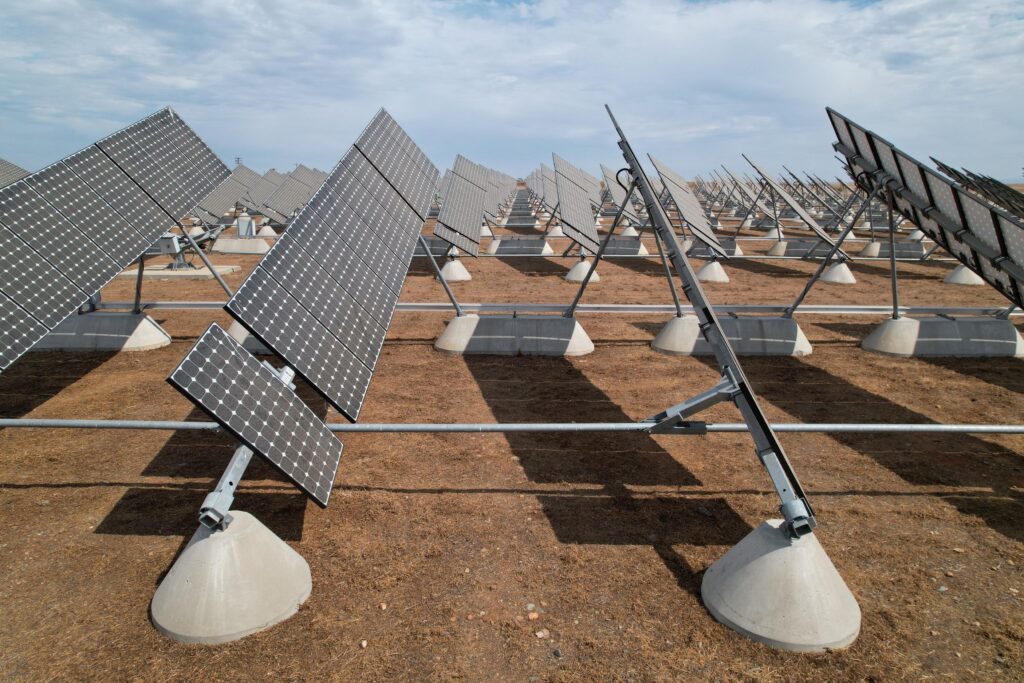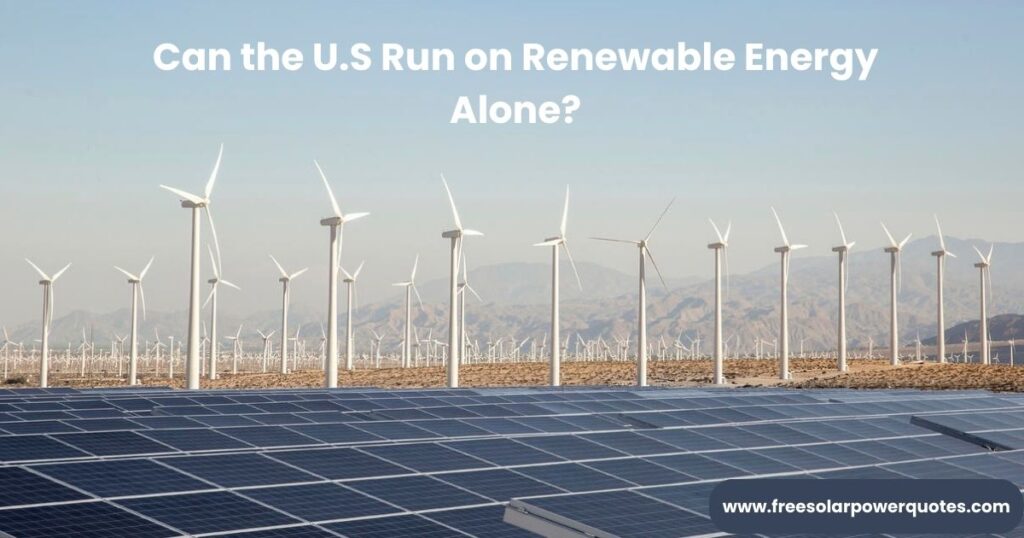Renewable energy has been a topic of growing interest and discussion in the U.S. in recent years, as the country aims to reduce its reliance on fossil fuels and address the environmental impacts of energy production. Can the US run on renewable energy alone? This article explores the different factors that influence the feasibility of a renewable energy-based system and analyzes the potential benefits and challenges of such a transition.
Energy Demand
The country’s energy demand is one of the primary factors determining whether the U.S. can run on renewable energy. As per U.S. Energy Information Administration, in 2019, the U.S. consumed approximately 100 quadrillion British thermal units (Btu) of energy, most of which came from fossil fuels such as petroleum, natural gas, and coal.
Renewable energy sources have the potential to meet the country’s energy demand. Still, significant investments and policy changes will be required to expand the infrastructure and scale up renewable energy production. Additionally, energy storage devices may be needed to ensure a constant energy supply from renewable energy sources like wind and solar, which are weather-dependent.
Available Renewable Energy Sources
The U.S. is fortunate to have a wide range of renewable energy sources available, including wind, solar, hydro, geothermal, and biomass. The largest contributor to the renewable energy mix in the U.S. is currently wind power, followed by hydropower and solar energy.
The potential for renewable energy sources in the U.S. is enormous, with some studies indicating that the country could meet all of its energy needs through renewable energy alone. One analysis by the National Renewable Energy Laboratory concluded that by 2050, the United States could get 80% of its electricity from renewable sources like wind and solar.
However, while the potential for renewable energy is significant, it should be noted that the available resources vary depending on the geographical location. For instance, areas with strong wind patterns and ample sunlight will have a greater potential for wind and solar energy production. Moreover, certain renewable energy sources, such as hydro power, are geographically dependent, and not all areas have the necessary infrastructure to harness them.
Infrastructure and Grid Modernization
Significant investments will be required in the infrastructure and the grid system to achieve a fully renewable energy-based system. Renewable energy sources tend to be more decentralized than traditional energy sources, which means that new infrastructure will need to be built to support the widespread production and distribution of renewable energy.
Furthermore, supporting renewable energy integration requires grid modernization. The grid system is currently designed for centralized power plants that are controlled by a small number of companies. Still, a renewable energy-based system will require a more decentralized and diverse grid capable of handling fluctuations in energy supply.
Policy and Government Support
The transition to renewable energy will also require significant policy changes and government support. Incentives such as tax credits and grants can help spur investment in renewable energy infrastructure and technology, and regulations can also play a critical role in encouraging the adoption of renewable energy.
Moreover, the government’s support for renewable energy can help to reduce the cost of renewable energy production and accelerate its deployment. One notable example of government support for renewable energy in the U.S. is the Investment Tax Credit, which provides a 26% tax credit for solar energy systems installed on residential and commercial properties.
To gain a comprehensive understanding, refer to the guide ‘Solar Panels for Homes in the USA‘
Cost and Economic Impact
One of the main concerns about the transition to renewable energy is the initial investment cost, which may be significant. However, the cost of renewable energy technology has been steadily decreasing over the past decade, making it more economically competitive with traditional energy sources. Furthermore, the long-term economic benefits of renewable energy, such as reduced dependence on volatile energy markets and reduced environmental impacts, can outweigh the initial investment costs.
Another potential economic impact of the transition to renewable energy is the potential for job creation. Renewable energy might offer millions of employment in manufacturing, construction, and installation. Additionally, renewable energy can help revitalize rural economies, as renewable energy projects often occur in areas where resources are abundant.
Environmental Benefits
The environmental benefits of renewable energy are clear. Unlike traditional energy sources, renewable energy emits little to no greenhouse gas emissions, contributing to climate change. Protecting natural habitats and ecosystems from the effects of energy production, renewable energy can help lessen the environmental implications of conventional energy sources, including air and water pollution.
Furthermore, the transition to renewable energy can help mitigate climate change’s impacts, such as more frequent and severe weather events, rising sea levels, and droughts, which can have significant economic and social consequences.

How much renewable energy is used in the United States?
The United States generated approximately 784,862 thousand megawatt hours (MWh) of renewable energy. This accounted for about 12.8% of the country’s total electricity generation, according to the U.S. Energy Information Administration (EIA).
The EIA breaks down the sources of renewable energy used in the U.S. electricity mix as follows:
- 64% from hydroelectric power
- 21% from wind power
- 8% from solar power
- 6% from biomass
- 1% from geothermal
It’s worth noting that the percentage of renewable energy used in the U.S. has been growing in recent years, and the amount of renewable energy generated has likely increased since 2021. The EIA publishes regular updates on U.S. electricity generation, so you can check their website for more current data.
Conclusion
In conclusion, the U.S. has the potential to run on renewable energy, but significant investments and policy changes will be required to achieve this goal. The availability of renewable energy resources and the demand for energy in different areas will also play a critical role in determining the feasibility of a renewable energy-based system.
Moreover, the transition to renewable energy will require a significant overhaul of the infrastructure and grid system and strong government policy support. However, renewable energy’s economic and environmental benefits, such as job creation and reduced greenhouse gas emissions, make the transition to renewable energy a worthwhile investment for the future of the U.S. and the planet.
Ready to start saving money and reducing your carbon footprint? Reach out to us today at freesolarpowerquotes.com to receive a custom quote for solar power. Let’s make the switch to renewable energy together!
FAQS
What constitutes renewable energy?
Renewable energy includes sun, wind, hydro, and geothermal power, all of which are regenerated naturally and sustainably.
Can the U.S. run on renewable energy alone?
While the U.S. has the potential to run on renewable energy, it would require significant investments in infrastructure, technology, and policy changes to achieve this goal.
What economic benefits does renewable energy provide?
Among the economic advantages of renewable energy are the following:
- Reduced dependence on volatile energy markets.
- Job creation in the renewable energy industry.
- Long-term cost savings.
What are the environmental benefits of renewable energy?
The environmental benefits of renewable energy include reduced greenhouse gas emissions, reduced air, and water pollution, and protection of natural habitats and ecosystems.
What is the current state of renewable energy in the U.S.?
Renewable energy is growing in the U.S., but it still only makes up a small percentage of total energy production. Solar and wind energy are the fastest-growing sources of renewable energy.
What role does policy play in the transition to renewable energy?
Strong policy support from the government is essential in the transition to renewable energy, including incentives and regulations to promote renewable energy development and use.
What are the challenges in transitioning to renewable energy?
Challenges in transitioning to renewable energy include:
- The initial costs of investment.
- The need for updated infrastructure.
- Balancing the demand for energy with the availability of renewable resources.
How does renewable energy compare to traditional energy sources in terms of cost?
While the initial investment costs of renewable energy can be high, the long-term cost savings and benefits can outweigh these costs, making renewable energy increasingly economically competitive with traditional energy sources.
What are some examples of successful renewable energy projects in the U.S.?
Successful renewable energy projects in the U.S. include the Ivanpah Solar Power Facility in California, the Cape Wind offshore wind project in Massachusetts, and the Hoover Dam in Nevada, which produces hydroelectric power.
Can individual households use renewable energy?
Yes, individual households can use renewable energy sources, such as installing solar panels on their homes or using wind turbines, to power their homes and reduce their reliance on traditional energy sources.
What percent of the U.S. is power renewable?
Renewable energy sources accounted for approximately 12.8% of total electricity generation in the United States, according to the U.S. Energy Information Administration (EIA). This includes energy from wind, solar, hydropower, biomass, and geothermal sources.
It’s worth noting that the share of renewable energy in the U.S. electricity mix has been growing in recent years, and the percentage has likely increased since last year. The EIA publishes regular updates on U.S. electricity generation, so you can check their website for more current data.
What is the United States’ stance on green energy?
The United States government has made efforts to promote and transition to green energy, including setting targets for reducing greenhouse gas emissions and providing incentives for renewable energy development.

